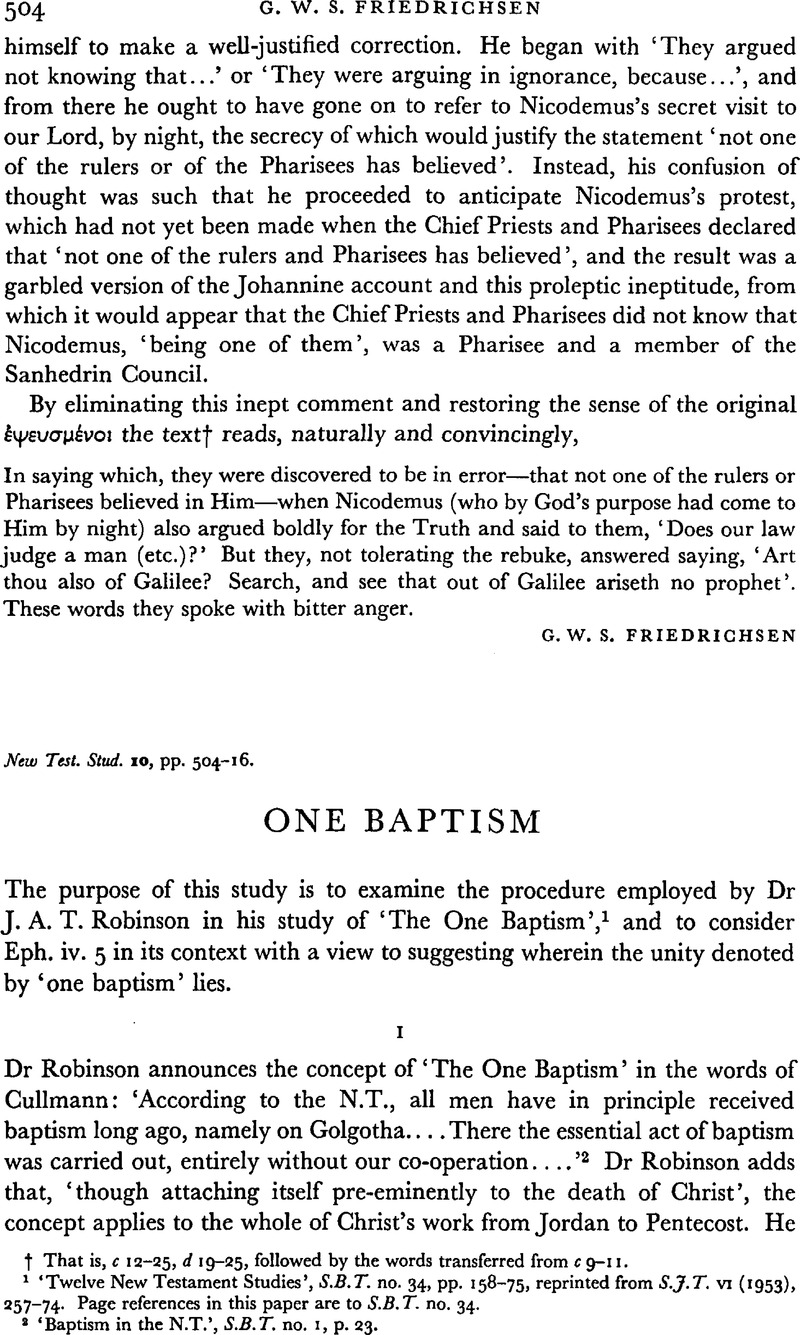No CrossRef data available.
Article contents
Abstract

Information
- Type
- Short Studies
- Information
- Copyright
- Copyright © Cambridge University Press 1964
References
page 504 note † That is, c 12–25, d 19–25, followed by the words transferred from c 9–11.
page 504 note 1 ‘Twelve New Testament Studies’, S.B.T. no. 34, pp. 158–75Google Scholar, reprinted from S.J.T. vi (1953), 257–74.Google Scholar Page references in this paper are to S.B.T. no. 34.
page 504 note 2 ‘Baptism in the N.T.’, S.B.T. no. 1, p. 23.
page 505 note 1 Cf. Moulton, J. H., Grammar, I, 120Google Scholar, on the present denoting future time. ‘We may define the futural present as differing from the future tense mainly in the tone of assurance which is imparted.’ My italics.
page 506 note 1 Syst. Theol. II, 151–2.Google Scholar Cf. also Manson, T. W., The Sayings of Jesus (S.C.M., 1949), p. 120.Google Scholar On this passage Manson says: ‘The nearest parallel to this tragedy is to be found in the “Confessions” of Jeremiah, where there is a similar struggle in the prophet's mind “between fidelity to his prophetic commission and the natural feelings and impulses of his heart” (Skinner, , Prophecy and Religion, p. 210).’Google Scholar Manson compares Jer. xx. 9 and speaks of ‘the natural shrinking from a terrible necessity, and the clear vision that the task must be carried out’. He interprets the ‘baptism’ here much in the same way as V. Taylor on Mark x. 38.
page 506 note 2 Cf. Luke viii. 45; xix. 43. Abbott-Smith, , s.v., compare Matt. iv. 24; Luke iv. 38; viii. 37; Acts xxviii. 8.Google Scholar
page 506 note 3 Cf. II Cor. v. 14 ή γάρ άγάπη τοũ χρıστοũ συνέχεı ήμᾷς.
page 506 note 4 Manson, T. W., op. cit. p. 120.Google Scholar
page 506 note 5 Hück-Lietzmann, , Synopsis, refer at this point (Luke xii. 50) to John xii. 27.Google Scholar The Johannine passage has the same atmosphere as the Lukan, the suggestion of protest combined with acceptance of the will of God, but without reference to baptism.
page 506 note 6 Cf. Dodd, C. H., ‘The Johannine Epistles’, M.N.T.C. (1946), pp. 127–31.Google Scholar
page 507 note 1 Dodd, C. H., op. cit. p. 131.Google Scholar
page 507 note 2 Cf. C., Kingsley Barrett, The Gospel according to St John, on ūδωρ ʒῶν in John iv. to, p. 195. Barrett finds the roots of the conception in the O.T.: ‘Living water as a metaphor for divine activity in quickening men to life.’ He cites Jer. ii. 13; Zech. xiv. 8; and especially Ezek. xlvii. 9. ‘The water is pre-eminently the Holy Spirit, which one gives life.’
page 507 note 3 It is possible to make too much of this evangelist's verbal variations, cf. xxi. 15, where άγαπάω and φıλέω are synonyms. If there is a difference it would seem that λοúω applies to the body, νıπτω to parts of it.
page 508 note 1 p. 165. Cf. Dodd, C. H., The Interpretation of the Fourth Gospel (Cambridge, 1953), p. 401.CrossRefGoogle Scholar
page 509 note 1 Cf. Lightfoot, J. B., Commentary ad loc.Google Scholar, who suggests that the aorists περıετμήθητε, etc., point to ‘the time of their baptism when they “put on Christ”’.
page 509 note 2 M.N.T.C. p. 239.Google Scholar Cf. also Robinson, Armitage, Comm. (Macmillan, 1907)Google Scholar: ‘τò ῥῆμα stands on the one hand for the Christian teaching (cf. v. 17 δıά ῥήματος χρıστοῦ), and on the other for the Christian confession which leads to salvation’.
page 509 note 3 Moulton, , Grammar, 1, 130 f.Google Scholar The footnote on p. 131 observes the doctrinal importance of the coincident aor. ptcp. in Acts xix. 2.
page 511 note 1 M.N.T.C. I Cor. (1938). p. 129.Google Scholar
page 512 note 1 Dr Robinson's note on ένεκαìνıσεεν on p. 172, appears to give some support to this view, though the reference to Exodus xxiv. 8 (via Heb. ix. 18) is to a dedication of the people.
page 512 note 2 Moffatt, J., ‘Hebrews’, I.C.C. (1924), p. 145.Google Scholar
page 512 note 3 Selwyn, E. G., I Peter (Macmillan, 1947), p. 205.Google Scholar
page 513 note 1 See Charles, R. H., I.C.C. (1920), ii, 133.Google Scholar ‘When our author wishes to express a thought of this nature (sc. that the blood is his own) he speaks of the άρνíον…ώς έσψαγμένον (v. 6).’
page 513 note 2 See also Charles, R. H. on Rev. iii. 5, op. cit.Google Scholar
page 513 note 3 See Taylor, V., op. cit., ad loc.Google Scholar
page 513 note 4 See Barr, James, ‘Biblical Words for Time’, S.B.T. no. 33 (1962), 154.Google Scholar
page 513 note 5 Scott, E. F., M.N.T.C. (1930), p. 204.Google Scholar
page 515 note 1 Lietzmann, H., A History of the Early Church, i, 169.Google Scholar
page 515 note 2 See further Robinson, J. Armitage, St Paul's Epistle to the Ephesians (2nd ed. 1907), p. 178Google Scholar; Abbott, T. K., ‘The Epistle to the Ephesians’, I.C.C., p. 109.Google Scholar
page 515 note 3 Schlier, H., Brief an die Epheser (1957), pp. 186 ff.Google Scholar

